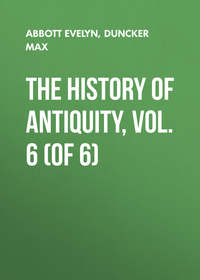 полная версия
полная версияThe History of Antiquity, Vol. 4 (of 6)
313
Manu, 10, 43-45.
314
Lassen, "Ind. Alterth." 1, 396, 439, 534.
315
Sherring, "Hindu Castes and Tribes," 7-9; 120, 247.
316
"Açvalayana Çrauta-Sutra," book 12, in M. Müller, "Hist. of Sanskrit Lit." p. 381.
317
Manu, 3, 27-38, 160, 171; 9, 100, 127 ff. The analogous series in the Açvalayana in A. Weber, "Indische Studien," 5, 284.
318
Açvalayana, Yajnavalkya, Apastamba in M. Müller, loc. cit. p. 378 ff.
319
A. Weber, "Indische Studien," 5, 343, 400, 407.
320
Strabo, p. 709. Arrian, "Ind." 17.
321
"Açvalayana," 1, 63, in A. Weber, loc. cit.
322
Manu, 9, 88-96.
323
Açvalayana says: "There are many different customs in different districts and towns; we only give what is common." Haas and A. Weber in the "Indische Studien," 5, 281.
324
Weber, loc. cit. 5, 219, 236.
325
A. Weber, loc. cit. 5, 201.
326
Haas, loc. cit. 5, 322, cp. however, p. 358.
327
A. Weber, loc. cit. 5, 214.
328
The first part of the sentence is from the latest part of the Rigveda (10, 184), the second from the Atharvaveda, 2, 30; 5, 25. in A. Weber, "Ind. Studien," 5, 218, 227, 234.
329
Manu, 9, 147-149; 3, 6-11; 55-62; 9, 2-7, 77-83.
330
Manu, 8, 371-376.
331
Manu, 7, 77, 78.
332
Rigveda, 10, 40 in Aurel Mayr, "Indisches Erbrecht," s. 79.
333
Manu, 9, 59-69, 144-146. Aurel Mayr, loc. cit. 3, 104.
334
Manu, 5, 157-162.
335
Manu, 5, 167-169.
336
e. g. "Ramayana," ed. Schlegel, 2, 3, 31.
337
Burnouf, "Introduction," p. 238.
338
Aurel Mayr, "Indisches Erbrecht," s. 160 ff.
339
Aurel Mayr, loc. cit. s. 56.
340
Manu, 9, 104-220. Burnouf, "Introduction," p. 239. In the sutras we are told of a division in a merchant's family, after the brothers have united; in this the oldest retains the house and lands, the other the shops, the third the stock, beside land. Burnouf, loc. cit. p. 242.
341
Aurel Mayr, loc. cit. 3, 167, ff.
342
Manu, 2, 29-34.
343
Above, p. 252. M. Müller, "Hist. of Anc. Sanskrit Lit." p. 380, ff.
344
Sherring, loc. cit. p. 122.
345
Lassen, "Ind. Alterth." 2, 80.
346
M. Müller, "Hist. Anc. Skt. Lit." p. 469 ff.
347
"Rigveda," 1, 162, according to M. Müller's translation, loc. cit. p. 553 ff.
348
"Çatapatha-Brahmana," 13, 3, 1, 1, in M. Müller, loc. cit. p. 37 ff.
349
"Ramayana," ed. Schlegel, 1, 11 ff. A. Weber, "Vorles." s. 1262.
350
"Vishnu-Purana," ed. Wilson, p. 470, 471. Lassen, "Ind. Alterth." 22, 319, 346, 963, 1001.
351
M. Müller has placed the period of the origin of the Brahmanas in the period from 800 to 600 B.C. – very successfully, so far as I can see. The collection of the Atharvan will belong to the end of this period, but not merely on the internal ground of the increase in the ceremonial brought about with and through the Brahmanas. The book of the law consistently cites the triple Veda; the sutras of the Buddhists and the Epos as consistently cite four. That the magic formulas of Atharvan and Angiras are quoted in Manu 11, 33, and not those of the Atharvaveda, seems also to prove that the latter collection was not made when the citations were written. Cp. A. Weber, "Vorl." s. 1652.
352
"Rigveda," 10, 9, 5-7.
353
"Atharvaveda," 5, 19, 2, 1-5.
354
Darmesteter, "Haurvatat," p. 74.
355
"Atharvaveda," 2, 9.
356
"Atharvaveda," 1, 25, 2, 8, quoted by Grohmann in Weber's "Ind. Stud." 9, 391, 403, 406 ff. If Takman is called Deva, this is due to the connection in which he is placed with Varuna. Varuna sends diseases as punishments, dropsy, as a water-god, but fever also, and thus Takman can be called the son of Varuna.
357
"Rigveda," 1, 50, 11, 12; 10, 97.
358
Kuhn in his "Zeitschrift f. v. s." 13, 140 ff., where the coincidence of the German language is pointed out.
359
M. Müller, "Hist. Anc. Skt. Lit." p. 230 ff.; 245 ff. A. Weber, "Vorles." s. 482.
360
Burnouf, "Introduction," p. 456. M. Müller, loc. cit. p. 305. Lassen, loc. cit. 22, 474.
361
In the Brahmanas we only find traces of a quinquennial or sexennial cycle. A. Weber, in "Z. D. M. G." 15, 132. The worship of the Nakshatras, or houses of the moon, i. e. the division of the sky into 27 (later 28) parts by means of certain constellations as marks, is first found in a developed form in Buddha's time, as is proved by Burnouf and A. Weber ("Abh. d. Berl. Akad.," 1861, s. 320). Weber does not believe in the Indian origin of these stations of the moon; he regards them as Semitic, and borrowed from Babylonia, loc. cit. s. 363. The inquiry at what time these marks for the course of the moon according to the position of the stars were made astronomical has led to various results. Biot regards the year 2357 B.C. as the earliest point (the original number of 24 stations was increased to 28 about the year 1100 B.C.). A. Weber thinks that the period between 1472 and 536 B.C. is the space within which the observation of the Jyotisha was fixed ("Studien," 2, 240, 413, 414. "Abh. d. Berl. Akad." 1860, s. 284; 1861, s. 354, 364), and shows that the use of these houses of the moon in China, in the order usual there, cannot be proved before 250 B.C. The Chinese order corresponds to the latest Indian arrangement of the Nakshatras, cf. "Ind. Stud." 9, 424 ff., whereas the length given in the Jyotisha for the longest and shortest day, suits the position of Babylon, loc. cit. 1861, s. 361. The Veda knows the Nakshatras as stars but not as stations of the moon, though they are known as the latter in the Brahmanas. The Vedic names of several of the gods who preside over the stations (Aryaman, Bhaga, etc.) prove a tolerably ancient origin for the Nakshatras. The civic computation of time among the Buddhists is founded on them. Hence we may assume that this division of the sky was perhaps current among the Indians in the tenth century B.C.
362
A. Weber, in "Abh. d. Berl. Akad." 1861, s. 291.
363
Manu, 3, 162; 6, 50.
364
A. Weber, "Vorl." s. 224 ff. The first traces of astrology in the strict sense besides the mention in the book of the law are found in the sutras of the Buddhists, e. g. in Burnouf, loc. cit. p. 140, 141, if we do not prefer the accounts of the Greeks to those legends which were written in Magadhi (Pali) the native language of Magadha, and the central Ganges in general, and have come down in the form which they received in the middle of the third century B.C., but also contain fragments of far greater antiquity. In any case, preference must be given to the simple sutras (Burn. loc. cit. p. 232), and these lay great stress on the astrology and soothsaying of the Brahmans. After this we meet with numerous traces of astrology in the Epos; but the law-book of Yajnavalkya is the first to command the worship of planets.
365
M. Müller, loc. cit. p. 109 ff.
366
Muir, "Sanskrit Texts," 3, 245 ff.
367
A. Weber, "Indische Studien," 9, 2, 72, 74.
368
Manu, 1, 33-40, 61, ff.
369
Manu, 9, 31-34; 313-322.
370
"Ramayana," ed. Schlegel, 1, 51-65. In this extended form this episode may, it is true, have first arisen at a much later time, as is shown by the mention of Vishnu and Çiva, and the Yavanas (Greeks). If in spite of these additions which are not important, I confidently place it at this date, I do so because the importance of the penitent and his power over the gods, the creation of beings by the penance of saints, i. e. the degradation of the gods, must be placed before the appearance of Buddha. This is the essential hypothesis for the religion which the doctrine of Buddha found in existence. In the Mahabharata this legend is told more briefly. Muir, "Sanskrit Texts," 196 ff.
371
A. Weber, "Ind. Stud." 1, 414.
372
The Sankhya system, which Buddha found in existence, presupposes the Vedanta system. The latter system must therefore have been in existence before Buddha; Roer, "Lecture on the Sankhya Philosophy," Calcutta, 1854, p. 19. The Vedanta is expressly mentioned in Manu, 2, 160, as belonging to the study of the Veda. The names Mimansa and Nyaya are also mentioned in Manu, but only in the final part, which is very loosely connected with the whole (12, 109, 111).
373
Colebrooke, "Miscellaneous Essays," 1, 325 ff. M. Müller, "Beiträge zur Kenntniss der indischen Philosophie" in Z. D. M. G. 6, 6, 7.
374
Colebrooke, "Transactions of the Royal Asiatic Society," II, 1. Vans Kennedy, "Asiatic Journal," 1839, p. 441 ff. Köppen, "Religion des Buddha," s. 57 ff. Wuttke, "Geschichte des Heidenthums," 2, 257, 281, 399
375
It is in the later Upanishads that we first find the doctrine of Kapila called by the name Sankhya, Weber, "Vorles." s. 212; "Ind. Stud." 9, 17. As with the Vedanta system, so also with the Sankhya: in the Sankhya-Karika we have only a very late and compressed exposition in 72 çlokas; but as Buddhism is founded on this system we are more certain about the earlier form of it than in the case of the Vedanta.
376
Burnouf, loc. cit. p. 511.
377
Roer, "Lecture," p. 15; Köppen, "Religion des Buddha," s. 65.
378
"Sankhya-Karika," çl. 63.
379
"Sankhya-Karika," çl. 44. Burnouf, loc. cit. p. 520, 522.
380
"Sankhya-Karika," çl. 67. By the side of this keen scepticism the system of the Sankhya allows the gradation of creatures as fixed by the Brahmans to remain, and the migration of souls with some slight modifications. The lowest stage is formed by the minerals; above these are the plants, reptiles, birds, wild animals, domestic animals. These are followed by men in the order of the castes; and then come the regenerations in the form of demons, Piçachas, Rakshasas, Yakshas and Gandharvas; and last in the form of Indra, Soma, Prajapati, Brahman. Barthelemy St. Hilaire, "sur le Sankhya," p. 286.
381
Köppen, loc. cit. s. 69.
382
Roer, "Lecture on the Sankhya Phil." p. 14; "Introduction to the Çvetaçvatara-upanishad," p. 36; cf. "Sankhya-Karika," çl. 53-55. Muir, "Sanskrit Texts," 3, 133 ff.
383
Muir, loc. cit. 3, 108 ff.
384
Cp. p. 76, 145, 321.
385
Burnouf, "Introduction à l'histoire du Bouddhisme," p. 208, 209, 151.
386
Burnouf, loc. cit. p. 152.
387
Burnouf, loc. cit. p. 150.
388
Burnouf, loc. cit. p. 138, 205, 208.
389
Burnouf, loc. cit. p. 157, 172. Lassen, "Ind. Alterth." 1, 581-585.
390
Burnouf, loc. cit. p. 138, 415.
391
Burnouf, loc. cit. p. 141, 149, 343.
392
Burnouf, loc. cit. p. 141.
393
Burnouf, loc. cit. p. 139, 140, 149. Supra, p. 173.
394
Burnouf, loc. cit. p. 236, 420.
395
Burnouf, loc. cit. p. 241, 244 ff. "Dhammapadam," translated by A. Weber, 322.
396
Burnouf, loc. cit. p. 223, 238.
397
Burnouf, loc. cit. p. 247.
398
Burnouf, loc. cit. p. 245, 246.
399
Burnouf, loc. cit. p. 240.
400
Burnouf, loc. cit. p. 146, 187.
401
Above, p. 95. Our chronology for the epochs of Indian history depends essentially on fixing two points. The first is the accession of Chandragupta in Magadha, already mentioned, from which the year 315 B.C. is certain (cp. infra); the second point is the year of Buddha's death. The Bhagavata-Purana puts Buddha's death 2000 years after the beginning of the Kaliyuga (supra, p. 77); such a round number and so general a date cannot lay claim to credibility. Besides this we have a number of other Brahmanic statements about the date of Buddha's life, varying more or less, but equally untrustworthy. More weight would naturally be ascribed to the statements of the Buddhists; yet even these differ widely from each other. The Thibetans have fourteen different statements about the year of Buddha's death, which cover the interval from 2422 to 546 or 544 B.C. The Chinese Buddhists as a rule assign Buddha's death to the year 950 B.C., but Buddhism did not reach the Chinese till after the birth of Christ. The most trustworthy statement seems to be that of the Singhalese. Buddhism reached them soon after the year 250 B.C.; from the year 161 B.C. their chronology agrees with existing inscriptions: their chronological system and their era is based on the year of Buddha's death, which they place in 543 B.C. If this date is compared with the Brahmanic list of kings of Magadha we get the following results: Before Chandragupta the dynasty of the Nandas reigned for 88 years according to the Brahmanic accounts, and 22 according to the Singhalese. On this point I agree with Lassen and Gutschmid in preferring the statement of the Brahmans, because the error of the Singhalese may very easily have arisen from the fact that the reign of 22 years, which they give to the sons of Kalaçoka, was incorrectly repeated for the following dynasty. According to this the first Nanda ascended the throne of Magadha in the year 403 (315+88). From this year the items on the Singhalese list carry us up to the year 665 B.C. for the accession of Kshemadharman (Çiçunaga), and the year 603 B.C. for the commencement of the reign of Bimbisara (Gutschmid, "Beiträge," s. 79 ff.), who is succeeded by Ajataçatru eight years before Buddha's Nirvana ("Mahavança," 2, 32, p. 10, ed. Turnour), which thus falls in the year 543 B.C. If we keep to the Singhalese date for the Nanda dynasty, we arrive at the year 477 B.C. for Buddha's death. Bimbisara ascended the throne 198 years according to the Matsya-Purana, and 193 years according to the Vayu-Purana, before the first Nanda. If the year 403 B.C. marks the accession of the Nandas, Bimbisara according to the Matsya-Purana began to reign in 601 B.C., and according to the Vayu-Purana in 590 B.C. Between Bimbisara's accession in 603 B.C. and the end of Açoka of Magadha there intervene, according to the statements of the Buddhists, 375 years. If with this we compare the dates of the reigns in the list of kings in the Vayu-Purana from Bimbisara to Açoka, we get 378 years from the first year of Bimbisara to the last year of Açoka. There is also another fact which agrees with the era 543 B.C. According to the statements of the Singhalese the second synod of the Buddhists was held 100 or 110 years after Buddha's death, in the reign of Kalaçoka, i. e. in 443 or 433 B.C. ("Mahavança," ed. Turnour, p. 15). Of these two statements it is obvious that the more definite, 110 years, is more deserving of credit. According to the detailed statements of the Singhalese for the time of the separate reigns, Kalaçoka's reign begins 90 years after Buddha's death, i. e. 453; he reigns 28 years according to the Singhalese, i. e. if we reckon up the single items from Chandragupta (the Nandas 80, and Kalaçoka's sons 22 years) from 453 to 425 B.C. In this way the era of the Singhalese and the year of Buddha's death are completely justified. Still the year is not wholly beyond a doubt. According to the statement of the native Singhalese, Chandragupta ascended the throne 162 years (and the various items agree with this total) after Buddha's death, i. e. 162 years after the year 543 B.C., and therefore in the year 381 B.C., but we know that his accession took place in 315 B.C. Here we find an error of 66 years, which however we have already removed by adopting the Brahmanic statement of 88 years for the dynasty of the Nandas instead of the 22 years of the Singhalese. Further, it does not agree with the era of 543 B.C., when we are told by the Singhalese that the third Buddhist synod was held 118 years after the second, i. e. 228 years after Buddha's death. We know from inscriptions that this synod met in the seventeenth year of Açoka, Chandragupta's second successor. Açoka reigned from 265 to 228, or from 263 to 226 B.C.: his seventeenth year reckoned from 265 would be 249 B.C.; if we add to this 228 years we get 477 B.C. for the year of Buddha's death; thus we have here again the same error of 66 years. Lastly, it does not agree with the era of 543 B.C. when we are told that the fourth Buddhist synod was held 400 years after the death of Buddha, under Kanishka, king of Cashmere. Kanishka is a contemporary of Augustus and Antonius (Lassen, "Ind. Alterth." 2, 412, 413); and according to this statement, therefore, Buddha would have died about the year 400 B.C. As the number of 400 years given for the fourth synod is nevertheless designedly a round number, little weight is to be placed upon it, and the year 543 can be kept as the year of Buddha's death. Before the dynasty of the Nandas in Magadha (403-315 B.C.) the throne was occupied by the Kshatrabandhus or Çaiçunagas for 262 years (665-403 B.C.); before these came the Pradyotas with 138 years (803-665 B.C.), who were again preceded (as is shown above, p. 77) by the Barhadrathas with 615 years, i. e. from 1418 to 803 B.C. (Cf. Gutschmid in "Beiträge zur Geschichte des alten Orients," s. 76, 87, and in "Zeitschrift d. D. M. G." 18, 372 ff.)
402
As the Arian colonists go from Surashtra to Ceylon about the year 500 B.C., this kingdom must have been in existence in the sixth century B.C. Burnouf, "Introduction," p. 166 ff.
403
Burnouf, loc. cit. p. 427.
404
Burnouf, loc. cit. p. 407.
405
Burnouf, loc. cit. p. 245.
406
Burnouf, loc. cit. p. 237, 432.
407
Burnouf, loc. cit. p. 146, 514.
408
Burnouf, loc. cit. p. 423.
409
Burnouf, loc. cit. p. 175, 261, 380.
410
If I ascribe the rise of Vishnu and Çiva primarily to the people, this is done because the need pointed out must have been felt most deeply by them; two rival deities would never have been elevated to supreme positions if the movement had not begun from beneath, and the life in two different districts had not formed the starting-point.
411
Muir, "Sanskrit Texts," 4, 67 ff.
412
"Vanaparvan," 484 ff. in Muir, loc. cit. 4, 136.
413
Muir, loc. cit. 4, 124 ff., 127.
414
Muir, loc. cit. 4, 131, 252 ff. The epithet of Vishnu, Upendra, i. e. Beside-Indra, points to this position.
415
Manu, 12, 121.
416
Burnouf, loc. cit. p. 137; A. Weber, "Ind. Studien," 2, 20; Lassen, "Ind. Alterth." 12, 918.
417
Muir, loc. cit. 4, 300-320.
418
Muir, loc. cit. 4, 184, 230, 269. Lassen, loc. cit. 12, 922. On the seats of the worship of Çiva on the coasts of the Deccan in the Mahabharata, cp. Muir, loc. cit. 44, 28, 285.
419
Nandin means having delight, delighted.
420
In the book of the law Vishnu is mentioned once only (12, 121), and Çiva not at all. The old sutras of the Buddhists, on the other hand, as has been stated, mentioned Çiva frequently under the name Çankara, and Vishnu under the names Hari and Janardana. Lassen has rightly perceived that the Narayana of the ancient sutras and of the law-book was not yet Vishnu, but Brahman, and Narayana was not transferred to Vishnu till later ("Alterth." 12, 918; 22, 464). The Mahavança (7, 47, ed. Turnour) mentions Vishnu as the tutelary deity of the earliest settlers in Ceylon. This settlement took place about 500 B.C., while Çiva appears as the tutelary deity of the somewhat more ancient Mathura in the south. The rise of the worship of Çiva and Vishnu according to these indications must be placed between 600 and 500 B.C. Panini is acquainted with Avataras of Vishnu (Lassen, loc. cit. 12, 921); in the accounts of the Greeks Krishna is already identified with Vishnu, and is widely worshipped both in the valley of the Ganges and in the extreme south of India, while Çiva is worshipped in the mountains. The development of this worship must therefore have taken place between 500 and 300 B.C., and no doubt chiefly in the second part of this period.
421
Burnouf, "Introduction," p. 146.
422
Köppen, "Religion des Buddha," s. 84. Kapilavastu means habitation of Kapila. It was the philosophy of Kapila which lay at the base of the teaching of Buddha.
423
The Gautamas were the most important priestly family among the Videhas. Lassen, "Ind. Alterth." 1, 557; 2, 67; Burnouf, "Introduction," p. 155; A. Weber, "Ind. Studien," 1, 180.
424
Burnouf, loc. cit. p. 154.
425
Burnouf, loc. cit. p. 77, 154, 157.
426
Köppen, loc. cit. s. 94.
427
Burnouf, loc. cit. p. 70.
428
Köppen, on the ground that Ujjayini is not mentioned among the southern Buddhists, limits the sphere of the activity of Buddha to the triangle formed by Champa, Kanyakubja, and Çravasti.






